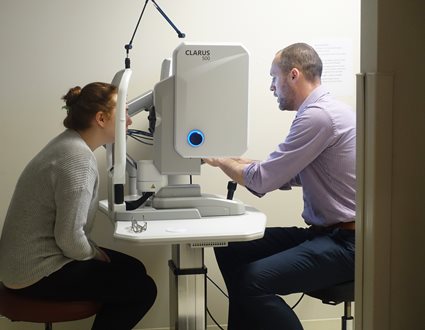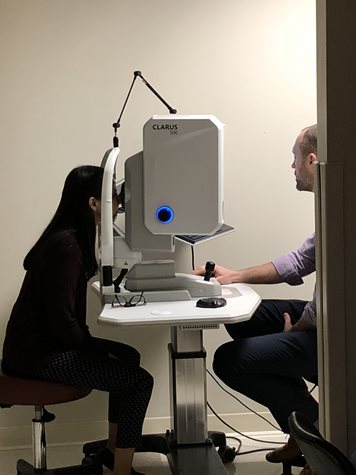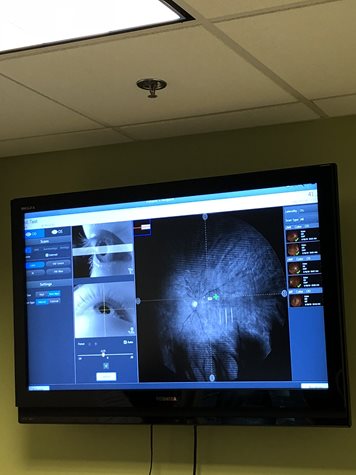The Eye Institute Newest Imaging Technology
 The Eye Institute (TEI) is excited to introduce the newest state-of-the-art technology for its patients. The Zeiss Clarus 500 provides a larger and more enhanced view of the retina than previous versions of imaging technology.
The Eye Institute (TEI) is excited to introduce the newest state-of-the-art technology for its patients. The Zeiss Clarus 500 provides a larger and more enhanced view of the retina than previous versions of imaging technology.
It is also the first and only fundus imaging system to provide true color and clarity within an ultra-wide field of view, enabling optometrists, ophthalmic technicians and optometric interns at TEI to capture high-resolution fundus images from the macula – the small but important area in the center of the retina - to the far edge. You need the macula to see details clearly in front of you.
Wide field retinal imaging is important because indications of disease – such as glaucoma or diabetic retinopathy - are often located in the far outside of the retina, which is used for sharp, central vision. Color accuracy is important because color can be the deciding factor when it comes to the diagnosis of ocular disease.
 The Clarus also allows a selection of red, green, and blue filters, enhancing the visual contrast of details in certain layers of the retina. Red filters allow the examiner to study the choroid in more detail. This can be helpful in visualizing choroidal lesions such as nevi – eye freckles - or tumors. Green filters provide an outstanding contrast of the retina, making vasculature and hemorrhages more visible. Whereas, blue filters increase the prominence of anterior retinal layers, allowing easier visualization of the retinal nerve fiber layer and the eye’s epi-retinal membranes.
The Clarus also allows a selection of red, green, and blue filters, enhancing the visual contrast of details in certain layers of the retina. Red filters allow the examiner to study the choroid in more detail. This can be helpful in visualizing choroidal lesions such as nevi – eye freckles - or tumors. Green filters provide an outstanding contrast of the retina, making vasculature and hemorrhages more visible. Whereas, blue filters increase the prominence of anterior retinal layers, allowing easier visualization of the retinal nerve fiber layer and the eye’s epi-retinal membranes.
From the patient’s point of view, the Clarus is a quick capturing device that requires the patient to easily place their forehead and chin on a stable head and chin rest. The machine brings the optics to the patient, facilitating an easy and comfortable scan.
Even as you zoom in on the optic nerve, the resolution of the photo remains intact and so do the details. Different patients have different retinal coloration and contrasts between their retina and optic nerve. Some patients, such as those with glaucoma, may have washed out optic nerves that are difficult to capture.
 But, the Clarus 500’s sweeping LED lights allow for a properly exposed optic nerve every time, regardless of the retina to nerve contrast. According to Dr. Maria Parisi, associate dean for Optometric Clinical Affairs at TEI, this new technology can be beneficial for patients that don’t want to be dilated as an option for hard to capture imagery in the far region of an undilated pupil - as long as the patient doesn’t have flashers or floaters. “It’s also good for patients who have diabetic retinopathy, for example, to further document it,” she said. Older traditional retinal cameras don’t capture this imagery and details as well.
But, the Clarus 500’s sweeping LED lights allow for a properly exposed optic nerve every time, regardless of the retina to nerve contrast. According to Dr. Maria Parisi, associate dean for Optometric Clinical Affairs at TEI, this new technology can be beneficial for patients that don’t want to be dilated as an option for hard to capture imagery in the far region of an undilated pupil - as long as the patient doesn’t have flashers or floaters. “It’s also good for patients who have diabetic retinopathy, for example, to further document it,” she said. Older traditional retinal cameras don’t capture this imagery and details as well.
Photos taken with the Clarus are saved in a patient’s electronic medical record at TEI and can be reviewed at any time. Retinal photos taken during previous visits can be compared to those taken on later visits to monitor eye conditions, assess for abnormal changes, and closely follow disease progression.
“Compared to other fundus capturing devices that I have worked with so far, the Clarus definitely captures much clearer images,” optometric intern, Maya Panchal, said. “I can see that TEI really cares about its patients and strives to provide the best technology to aid in their assessment.”